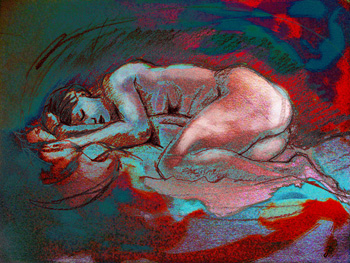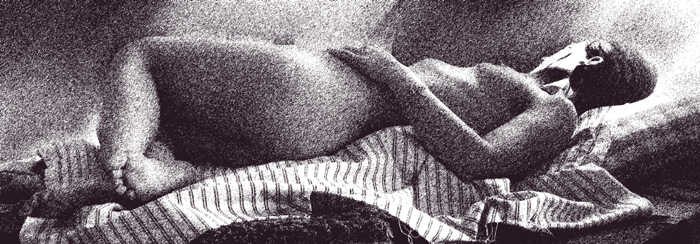 DIGITAL IMAGING AND MANIPULATION For years now I have been fascinated by what digital imaging allows you to do. The way one can manipulate and combine raw shots to create new images is fascinating. The process can be quick, but more often I find it is the result of several attempts and many wipes. Some images taken years earlier come back to haunt and combined with others or changed considerably they can end up very different from how they started. I also find myself constantly on the lookout for images that may work in combination with different textures such as trees, wood, stones and sky.
DIGITAL IMAGING AND MANIPULATION For years now I have been fascinated by what digital imaging allows you to do. The way one can manipulate and combine raw shots to create new images is fascinating. The process can be quick, but more often I find it is the result of several attempts and many wipes. Some images taken years earlier come back to haunt and combined with others or changed considerably they can end up very different from how they started. I also find myself constantly on the lookout for images that may work in combination with different textures such as trees, wood, stones and sky.

I draw and paint from life, take digital photographs and manipulate my own digital images. Is this “art” or only some of it? I use photographs ( unlike some – only my own) as a basis for many of my paintings. I change, manipulate and mix up my digital images. Is this art? I sometimes photograph my drawings, manipulate them or mix them up with other photos or digital images into a new composition. Is this art? Finally I print my images using a high end ink-jet printer. This is no automatic process for it often involves many trial runs and adjustments. So is an etching art but the use of such a printer not? Essentially what makes a work art and another work not? Basically in this context we are talking about two dimensional, flat images. We are not talking about buildings or three dimensional models or sculpture (though probably the same principles apply), so the question is – does it matter what processes are used to arrive at an image? I would say – no it does not. What is important is the quality of the end product. And how is the quality of the end product to be judged? Is it simply or basically a case of skill in handling a specific medium, be it pencil, paint, etching, manual or machine printing, camera or skill with photoshop? I think skill is important and has its place, a place now often underestimated, but what is that place? First I feel there is pleasure and satisfaction to be gained in contemplating or aquiring a work which demonstrates a consummate level of skill and control in the handling of any medium. In addition for each of us there is a defining moment when we recognise such a work reaches a point when we consider it to be of such quality and impact that for us personally we describe it or think of it as a work of art. So what is this point? When should we see something as a Work of Art I would suggest it is when someone produces what we find to be an arresting image, an image which engages and challenges the mind and the emotions, an image which speaks to the viewer and to its creator with some power, an image which remains in the mind and resonates, an image which comes back and haunts the mind and becomes a source of pleasure, pain, inspiration or compassion, an image which takes those who view it to somewhere they have never quite been before, an image which brings with it insight into who we are, an image which disturbs, challenges and faces us with a touch of trascendence. Different media bring this about in different ways. Everyone who attends a life-drawing class knows that sometimes the best drawings may be those done in five or ten minutes, other times, especially with paintings in oils, it can be work which takes many hours, weeks or even months. Then there is digital imaging. A photograph is an image which is usually captured in a moment of time, sometimes quite spontaneously, yet it can also be the result of meticulous planning , and its composition, cropping and subsequent manipulation (either in the dark room or on the computer) and its printing may be the result of many hours of painstaking work and obsessive concentration. So does this have any practical consequences? I think so. As the Royal Academy and the Royal West of England Academy have now recognised, ” Art” meaning not only paintings and hand crafted prints, but also photography and digital imagery, has become a recognised part of the Summer Exhibition and the RWEA Open Exhibition. Following this admirable lead I would suggest this means inkjet and traditional photographic prints should no longer be thought of as inhabiting seperate, (and by implication inferior?) worlds. This means exhibition organisers should not ban photographs or digital prints from being selected, provided all artists are open about what tools they use to carry out their visions. The same goes for prints. Be a work an etching, a conventional photographic print, an ink-jet print or an oil painting is immaterial. The selection committees responsible for open art exhibitions then (as opposed to exhibtions which focus on work in a single medium) I would suggest should apply the same basic criteria, ie is this an arresting and thought-provoking image etc, regardless of the medium in which it is expressed, so long as it is done well. Market demand of course then comes into play. What are people prepared to pay for an image? How important is the reputation of the artist, and is the buyer getting an exclusive “original” or one of a “limited edition”? Such questions will affect price, but they do not affect quality. As we all have seen rubbish and stale images, both “original” and prints can be sold for huge sums of money and sublime and unforgettable ones go for almost nothing. Nor does this matter, except to the starving artist, provided the trasaction is open and honest and the buyer is satisfied. One person’s piece of banal kitsch is another’s ecstatic experience and most loved possesion. Does this mean I am encouraging an” anything goes” relativism? I do not think so. Work that inspires, challenges and makes you think, work that resonates with honesty and compassion, work that expresses this with and through consummate skill in handling the chosen mediim will continue to be recognised by open and sensitive minds to have that quality which affords it the title Art. This will be true be it found on the walls of the Tate, in a colour supplement, or even on the web. Work I admire? Bit of a sucker for the Pre-Raphaelites. Beauty, colour, skill, emotion. Just back from being knocked out by Lucian Freud’s retrospective at the National Portrait Gallery. Usually find the work there at their annual exhibition of portrait artists superior to the RA summer show. Generally think abstract artists should stick to wall-paper and interior design. Expect artists to show real skill in the handling of their chosen medium, whatever it is. See the human body and the human face as central preoccupations of visual art – because we are programmed to find other humans beautiful, interesting, sexy, and able to convey emotions at a glance more than anything else. We anthropomorphise everything – including landscape, sea-scape, mountains, buildings.
